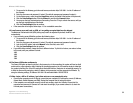
60
Appendix B:
Important Information for Wireless Products
Wireless-G ADSL Gateway
E. Change the SSID periodically.
F. Enable WEP 128-bit Encryption. Please note that this will reduce your network performance.
G. Change the WEP encryption keys periodically.
For information on implementing these security features, please refer to the User Guide.
4. Security Threats Facing Wireless Networks
Wireless networks are easy to find. Hackers know that in order to join a wireless network, wireless networking
products first listen for “beacon messages”. These messages are decrypted and contain much of the network’s
information, such as the network’s SSID (Service Set Identifier) and the IP Address of the network PC or access
point. Here are the steps you can take:
Change the administrator’s password regularly. With every wireless networking device you use, keep in
mind that network settings (SSID, WEP keys, etc.) are stored in its firmware. Your network administrator is the
only person who can change network settings. If a hacker gets a hold of the administrator’s password, he, too,
can change those settings. So, make it harder for a hacker to get that information. Change the administrator’s
password regularly.
SSID. There are several things to keep in mind about the SSID:
A. Disable Broadcast
B. Make it unique
C. Change it often
Most wireless networking devices will give you the option of broadcasting the SSID. While this option may be
more convenient, it allows anyone to log into your wireless network. This includes hackers. So, don’t broadcast
the SSID.
Wireless networking products come with a default SSID set by the factory. (The Linksys default SSID is “linksys”.)
Hackers know these defaults and can check these against your network. Change your SSID to something unique
and not something related to your company or the networking products you use.
Change your SSID regularly so that any hackers who have gained access to your wireless network will have start
from the beginning in trying to break in.


















